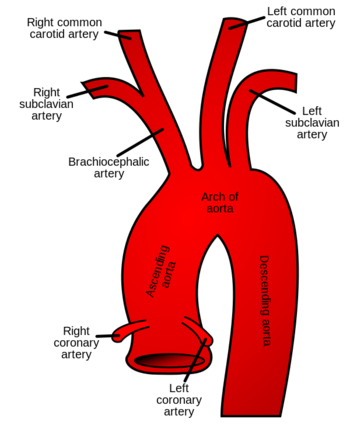Common Carotid Artery
Original Editor - Asma Alshehri
Top Contributors - Asma Alshehri, Kim Jackson, Adam Vallely Farrell, Lucinda hampton and Evan Thomas
Description[edit | edit source]
The Common Carotid artery is a large elastic artery which provides the main blood supply to the head and neck. The carotid arteries are the primary vessels supplying blood to the brain and face.
The right common carotid artery (RCCA) originates in the neck from the brachiocephalic artery
The left common carotid artery (LCCA) arises in the thorax from the arch of the aorta.
Both right and left common carotid arteries bifurcate in the neck at the level of the carotid sinus into the internal carotid artery (ICA), which supplies the brain, and the external carotid artery (ECA), which supplies the neck and face.[1]
Course:[edit | edit source]
The carotid arteries originate posterior to the sternoclavicular joints and in the neck, they are contained within the carotid sheath posterior to the sternocleidomastoid muscle.
- At the location of the upper border of the thyroid cartilage (typically at the level of the fourth or fifth cervical vertebra), the common carotid arteries bifurcate into the ECA and ICA.
- This bifurcation point is clinically significant as it serves as a point for the location of the "carotid body," a chemoreceptor, and the "carotid sinus," a baroreceptor.
- The carotid body chemoreceptor is sensitive to decreased PO2, increased PCO2, and decreased pH of blood, and is responsible for alerting the brain to change the respiratory rate. The carotid sinus baroreceptors respond to changes in the stretch of the blood vessel and are responsible for detecting changes and maintaining blood pressure.
- After its division, the ECA exits the sheath to provide oxygenated blood to the face and neck, while the ICA continues in the carotid sheath to enter the carotid canal within the temporal bone.[1]
Branches and divisions:[edit | edit source]
Each carotid artery branches into two divisions:
- The internal carotid artery supplies blood to the brain
- The external carotid artery supplies blood to the face and neck.[2]
Note:
(The left common carotid artery can be thought of as having two distinct parts: thoracic and cervical while the right common carotid artery has only a cervical portion since it arises cranially)[3]
Supply:[edit | edit source]
It mainly gives supply to the head and neck.
Clinical relevance:[edit | edit source]
The common carotid artery is frequently used in measuring a persons pulse, especially in those patients who are in shock and lack a detectable pulse in the more peripheral arteries of the body. The pulse is taken by palpating the artery just deep to the anterior border of the sternocleidomastoid muscle at the level of the superior border of the thyroid cartilage. The presence of a carotid pulse has been estimated to indicate a systolic blood pressure of more than 40 mmHg, as given by the 50% percentile.
Carotid stenosis:
It is a narrowing of the carotid arteries caused by a buildup plaque (atherosclerosis) inside the artery wall that reduces blood flow to the brain which my cause a stroke.
Plaque is a sticky substance made of fat, cholesterol, calcium and other fibrous material. [4]
Carotid Sinus Hypersensitivity:
Carotid sinus hypersensitivity is an increased response to carotid sinus stimulation, which can occur with advanced age, coronary artery disease or hypertension. External pressure on the carotid sinus can cause bradycardia and hypotension, which can lead to dizziness or syncope. Therefore, palpation of the carotid pulse is not recommended in patients with this condition.[5]
Carotid artery aneurysm:
A weak area of the carotid artery allows part of the artery to bulge out like a balloon with each heartbeat. Aneurysms pose a risk for breaking, which could result in stroke or severe bleeding, or hemorrhage.[2]
Carotid artery vasculitis:
Inflammation of the carotid artery, due to an autoimmune condition or an infection.[2]
References:[edit | edit source]
- ↑ 1.0 1.1 Sethi D, Gofur EM, Waheed A. Anatomy, Head and Neck, Carotid Arteries. InStatPearls [Internet] 2019 Jul 22. StatPearls Publishing. Available from:https://www.ncbi.nlm.nih.gov/books/NBK545238/ (last accessed 27.5.2020)
- ↑ 2.0 2.1 2.2 Picture of the carotid artery, http://www.webmd.com/heart/picture-of-the-carotid-artery#1 (accessed 31 may 2017)
- ↑ Common carotid artery, https://radiopaedia.org/articles/common-carotid-artery-2 (accessed 30 may 2017)
- ↑ Carotid stenosis, https://www.mayfieldclinic.com/PE-CarotidStenosis.htm (accessed 1 June 2017)
- ↑ Common carotid artery, https://www.kenhub.com/en/library/anatomy/common-carotid-artery (accessed 29 may 2017)







